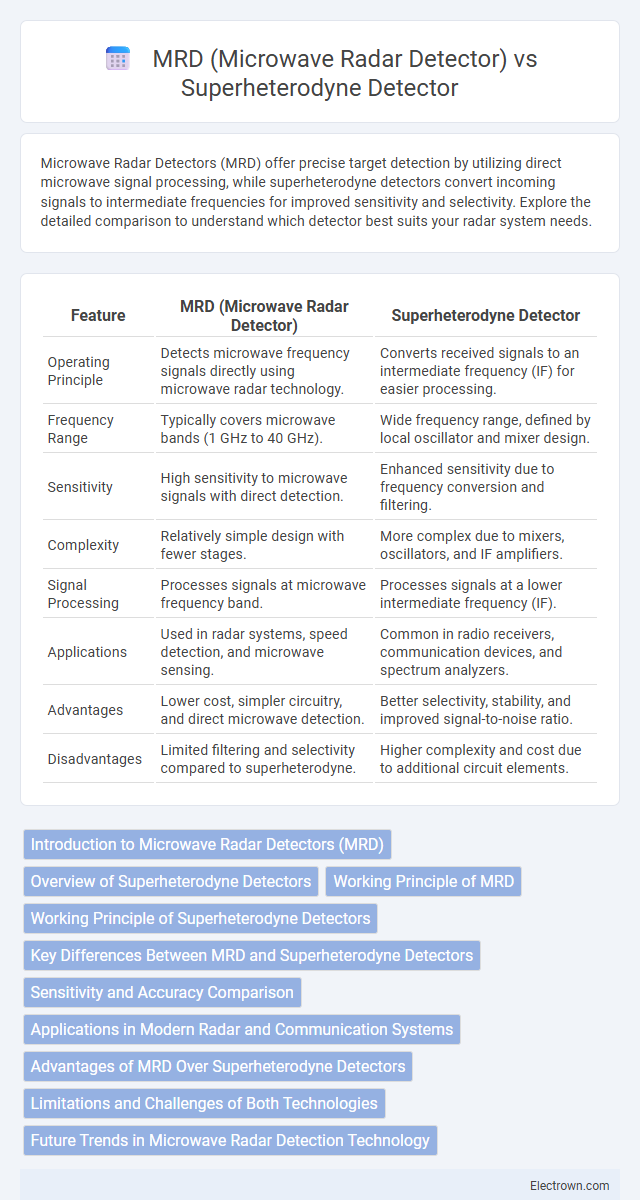Microwave Radar Detectors (MRD) offer precise target detection by utilizing direct microwave signal processing, while superheterodyne detectors convert incoming signals to intermediate frequencies for improved sensitivity and selectivity. Explore the detailed comparison to understand which detector best suits your radar system needs.
Table of Comparison
| Feature | MRD (Microwave Radar Detector) | Superheterodyne Detector |
|---|---|---|
| Operating Principle | Detects microwave frequency signals directly using microwave radar technology. | Converts received signals to an intermediate frequency (IF) for easier processing. |
| Frequency Range | Typically covers microwave bands (1 GHz to 40 GHz). | Wide frequency range, defined by local oscillator and mixer design. |
| Sensitivity | High sensitivity to microwave signals with direct detection. | Enhanced sensitivity due to frequency conversion and filtering. |
| Complexity | Relatively simple design with fewer stages. | More complex due to mixers, oscillators, and IF amplifiers. |
| Signal Processing | Processes signals at microwave frequency band. | Processes signals at a lower intermediate frequency (IF). |
| Applications | Used in radar systems, speed detection, and microwave sensing. | Common in radio receivers, communication devices, and spectrum analyzers. |
| Advantages | Lower cost, simpler circuitry, and direct microwave detection. | Better selectivity, stability, and improved signal-to-noise ratio. |
| Disadvantages | Limited filtering and selectivity compared to superheterodyne. | Higher complexity and cost due to additional circuit elements. |
Introduction to Microwave Radar Detectors (MRD)
Microwave Radar Detectors (MRD) utilize high-frequency microwave signals to detect objects by measuring the reflection and Doppler shifts, offering enhanced sensitivity and range in radar systems. Unlike superheterodyne detectors that convert incoming signals to intermediate frequencies for processing, MRDs process microwave signals directly, reducing signal loss and improving detection accuracy. These characteristics make MRDs ideal for advanced applications in military radar, automotive collision avoidance, and air traffic control systems.
Overview of Superheterodyne Detectors
Superheterodyne detectors convert high-frequency microwave signals into lower intermediate frequencies (IF) for easier processing, enhancing sensitivity and selectivity in radar systems. They mix incoming microwave signals with a locally generated oscillator signal, enabling precise frequency discrimination and improved noise reduction compared to direct detection methods. This architecture is widely used in Microwave Radar Detectors (MRD) to achieve superior detection performance across varied signal environments.
Working Principle of MRD
Microwave Radar Detectors (MRDs) operate by emitting microwave signals and analyzing the frequency shifts of the reflected waves caused by motion, utilizing the Doppler effect for precise speed detection. Unlike superheterodyne detectors that mix incoming signals with a local oscillator to convert frequency for easier processing, MRDs directly process the microwave frequency shifts to identify moving targets. This direct detection method in MRDs provides enhanced sensitivity and faster response times in applications such as speed enforcement and motion sensing.
Working Principle of Superheterodyne Detectors
Superheterodyne detectors operate by mixing the incoming microwave signal with a locally generated frequency to produce an intermediate frequency (IF) that is easier to process and analyze. This frequency conversion enhances sensitivity and selectivity by allowing more precise filtering and amplification at the IF stage. Your system benefits from improved detection accuracy and reduced noise compared to basic Microwave Radar Detectors (MRD) that rely solely on direct detection methods.
Key Differences Between MRD and Superheterodyne Detectors
MRD (Microwave Radar Detector) uses direct microwave signal detection to identify radar emissions, while superheterodyne detectors convert incoming signals to an intermediate frequency for enhanced selectivity and sensitivity. The MRD offers faster response times with simpler circuitry, but superheterodyne detectors provide superior frequency discrimination and reduced noise interference. Understanding these differences can help you choose the most effective radar detection technology for your specific application needs.
Sensitivity and Accuracy Comparison
Microwave Radar Detectors (MRD) typically offer higher sensitivity due to their ability to detect a broader range of frequencies with greater precision, making them ideal for applications requiring detailed signal analysis. Superheterodyne detectors excel in accuracy by converting received signals to a fixed intermediate frequency, which reduces noise and improves signal clarity, enhancing the reliability of target identification. When selecting Your detection device, consider that MRD provides superior sensitivity for faint signals, while superheterodyne detectors deliver enhanced accuracy for precise measurements.
Applications in Modern Radar and Communication Systems
Microwave Radar Detectors (MRD) excel in detecting high-frequency signals with enhanced sensitivity, making them ideal for modern radar systems used in air traffic control and automotive collision avoidance. Superheterodyne detectors offer superior frequency selectivity and stability, widely applied in communication receivers for reliable signal demodulation and low noise performance. Your choice between MRD and superheterodyne detectors depends on the specific system requirements for sensitivity, selectivity, and operational environment in radar and communication applications.
Advantages of MRD Over Superheterodyne Detectors
Microwave Radar Detectors (MRD) offer enhanced sensitivity and faster response times compared to superheterodyne detectors, making them ideal for real-time applications. MRDs provide improved noise immunity and simpler circuitry, which reduces overall system complexity and cost. These advantages result in more reliable detection performance, especially in cluttered or high-interference environments common to radar systems.
Limitations and Challenges of Both Technologies
Microwave Radar Detectors (MRD) face limitations such as susceptibility to false alarms from environmental clutter and limited sensitivity in detecting low-power radar signals. Superheterodyne detectors encounter challenges including complex circuitry that increases size and power consumption, as well as vulnerability to frequency drift affecting accuracy. Both technologies struggle with maintaining consistent detection performance in diverse and dynamic electromagnetic environments.
Future Trends in Microwave Radar Detection Technology
Advancements in microwave radar detection technology emphasize the integration of AI-driven signal processing with MRD (Microwave Radar Detector) systems to enhance target recognition accuracy and environmental adaptability. Superheterodyne detectors continue to evolve with the incorporation of low-noise amplifiers and digital intermediate frequency (IF) stages, improving sensitivity and frequency selectivity for complex radar environments. The future landscape prioritizes hybrid architectures combining MRD's real-time detection capabilities with superheterodyne's precise signal conversion, enabling multifunctional radar systems for autonomous vehicles, defense, and aerospace applications.
MRD (Microwave Radar Detector) vs superheterodyne detector Infographic

 electrown.com
electrown.com